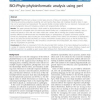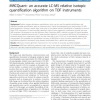89222 search results - page 17646 / 17845 » Which |
BMCBI
2011
13 years 5 months ago
2011
Background: Phyloinformatic analyses involve large amounts of data and metadata of complex structure. Collecting, processing, analyzing, visualizing and summarizing these data and...
BMCBI
2011
13 years 5 months ago
2011
Background: Phylogenetic trees are an important tool for representing evolutionary relationships among organisms. In a phylogram or chronogram, the ordering of taxa is not conside...
BMCBI
2011
13 years 5 months ago
2011
Background: Bioinformatic analyses typically proceed as chains of data-processing tasks. A pipeline, or ‘workflow’, is a well-defined protocol, with a specific structure defin...
BMCBI
2011
13 years 5 months ago
2011
Background: Relative isotope abundance quantification, which can be used for peptide identification and differential peptide quantification, plays an important role in liquid chro...
BMCBI
2011
13 years 5 months ago
2011
Background: Many practical tasks in biomedicine require accessing specific types of information in scientific literature; e.g. information about the results or conclusions of the ...


